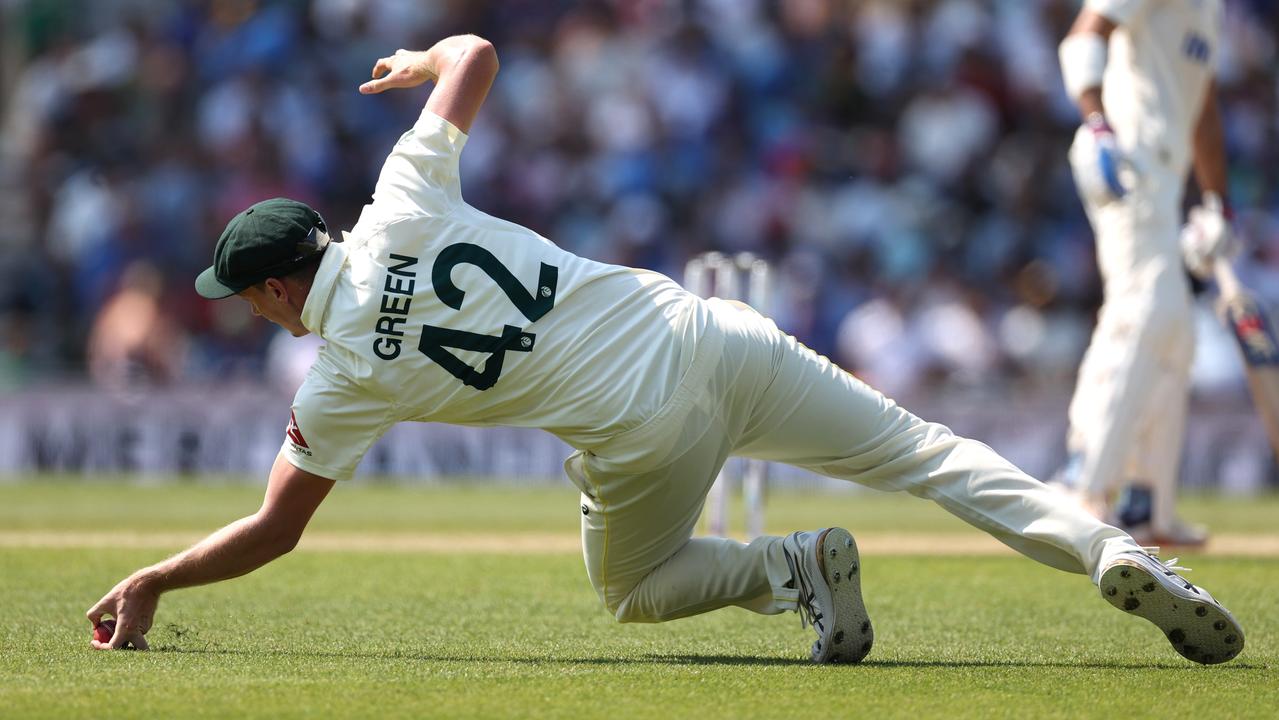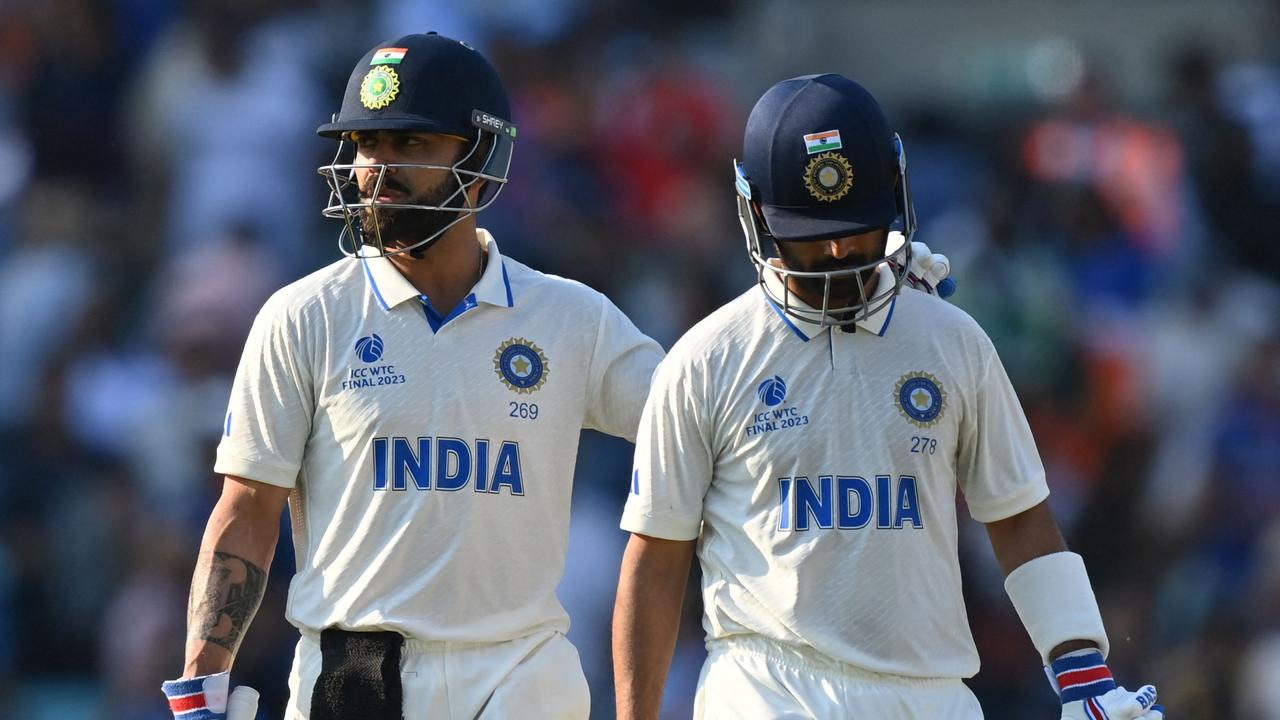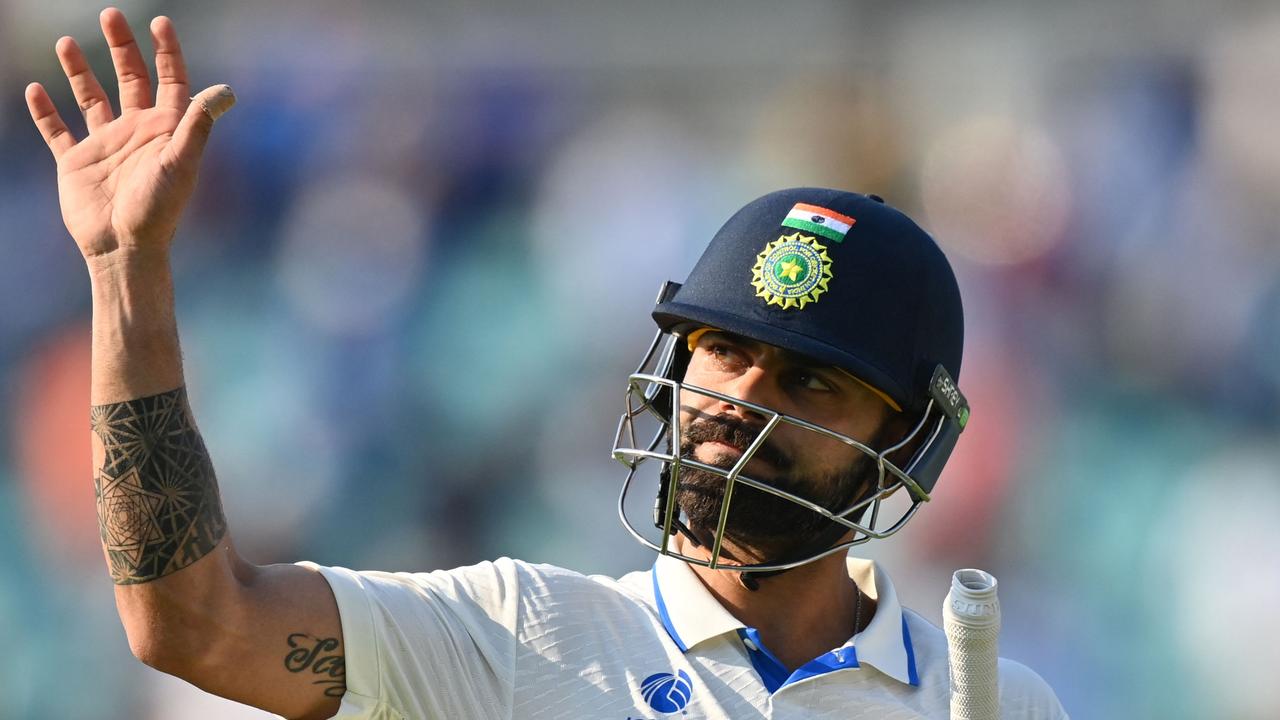Cameron Green’s controversial screamer against India during the World Test Championship final explained
Cameron Green is at the centre of the biggest controversy in the cricket world but the confusing drama can now be explained.

Cameron Green has the cricket world at his feet after snaring two extraordinary catches in the World Test Championship final at the Oval to take Australia one step closer to their first ICC Test title.
Diving low to his left at gully to snaffle an edge off India’s Shubman Gill, Green’s efforts were marvelled at by a cacophony of Australians on social media who appreciated the difficulty in moving his two-metre frame as quickly as he did.
Stream Over 50 Sports Live & On-Demand with Kayo. New to Kayo? Start your free trial now >
To Indian fans however, Green had committed a cardinal sin – he’d claimed a catch when the ball touched the ground, and was therefore a cheat.
UNBELIEVABLE.
— 7Cricket (@7Cricket) June 10, 2023
Cameron Green's done it again with another pearler!#WTCFinal | https://t.co/CAC5IeY420pic.twitter.com/O54hg1hdFQ
🔎🔎🤦ðŸ»â€â™‚ï¸ pic.twitter.com/pOnHYfgb6L
— Shubman Gill (@ShubmanGill) June 10, 2023
Indeed, Indian fans on seeing replays and seeing the ball hit the ground, proceeded to chant “cheat” as Green began to bowl.
The on-field umpires referred the decision to TV umpire Richard Kettleborough, standing in his 110th Test and 32nd as a TV umpire.
As a three-time ICC Umpire of the Year, Kettleborough’s credentials and judgment should be in theory, beyond reproach.
So much so that the controversy playing out on social media has begged the question: Why was Green’s catch considered fair, and Shubman Gill sent packing?
To understand this, we must look to Law 33 of the Laws of Cricket – the caught law.
33.2.2.1 explains that “a catch will be fair if the ball is held in the hand or hands of a fielder, even if the hand holding the ball is touching the ground”, and 33.3 defines the start and end points of a catch.
33.3 states “the act of making a catch will start from the time when the ball first comes into contact with a fielder’s person and shall end when a fielder obtains complete control over both the ball and (their) own movement.”

This means that for the purposes of the Laws of Cricket, the umpires needed to determine whether Cameron Green was (a) in control of the ball, (b) in control of his body, and (c) whether the ball touched the ground before that.
Australian Test great Ricky Ponting gave his thoughts after play to the ICC.
“When I saw it live, I knew it had carried to him on the full, but I wasn’t sure what the action was after that from all replays we have seen,“ Ponting said.
“I actually think some part of the ball did touch the ground and it is the interpretation of the umpire that as long as the fielder has complete control of the ball before the ball hits the ground then it is out.
“That must have been what the umpires’ interpretation was and I think that is exactly what happened.
“Everyone in India will think it is not out and everyone in Australia will think it is out.”

But because cricket is a ridiculous game, this isn’t the end of the matter.
The ICC Playing Conditions, under which the World Test Championship is played (as well as all other Test matches and almost all other international cricket), supersede the Laws (despite being mostly based on the Laws).
The Playing Conditions (unlike the Laws) include provisions relating to decisions made by third umpires and using television replays, and before May of this year, stated that the on-field umpires, if they were unable to decide on a fair catch, would refer it to the third umpire with an “indicatory soft signal”, which a third umpire would need conclusive replay evidence to overturn.
This was scrapped in May, with ICC cricket committee chair and former India Test captain Sourav Ganguly saying that the committee “concluded that soft signals were unnecessary and at times confusing since referrals of catches may seem inconclusive in replays.”

The soft signal came under scrutiny during the 2023 New Year’s Test in Sydney between Australia and South Africa, with a series of low catches sparking controversy amid a then-recent change to the Conditions by the ICC to allow third umpires to overturn on-field soft signals without conclusive evidence being required.
With the soft signal gone, the decision now lies completely in the hands of the third umpire based on television replays.
The ICC’s advice to umpires on how they interpret and judge catches in these situations is laid out in a document called the ICC Almanac, an updated version of which is not readily available to non-umpires.
A previous edition of the Almanac (dated to 2021, before the changes to the soft signal), states that “if the on field umpire initially indicated that he was unsure either way as to whether it was a fair catch and the third umpire states that replays are inconclusive, the batter should be given the benefit of the doubt, and the decision shall be not out.”
It goes on to state that “if the TV umpire believes that the replays are inconclusive, the TV umpire will rule out or not out depending on the soft signal.”
Green himself was insistent he took the catch fairly.
“At the time I definitely thought I caught it. I think in the heat of the moment I thought it was clean,” Green told media afterwards.
“It was left up to the third umpire and he agreed.”
Asked about a crowd made up almost entirely of Indian supporters, Green said he understood the reaction.
“Obviously the Indian crowd are so passionate and obviously one of the favourite guys Shubman Gill got out and I think that’s what they were all kind of looking forward to watching, so it is what it is and we move on,” he said.

Gill on the other hand, took to social media to express his displeasure, posting a still of the catch that appears to show a diving Green with the ball touching the ground, alongside magnifying glass and face palm emojis.
With Gill back in the pavilion, the burden of chasing what would be a world-record 444 to secure the World Test Championship falls on talisman and former captain Virat Kohli.
With India’s top three batters all dismissed, they still require 280 runs on day five on an increasingly difficult Oval wicket, and Kohli will need to add significantly to his 44 if India are to be in with a fighting chance of victory.
While it would require the biggest chase in Test history, as well as the highest fourth-innings score ever at The Oval, this India side have form in breaking Australian hearts, and so does English soil.
The 2020/21 Border-Gavaskar Trophy saw a bruised and battered India line-up bat 97 overs on day five to pull off an extraordinary draw in Sydney, before going on to break Australia’s 32-year unbeaten streak at the Gabba with a scarcely-believable fourth-innings effort from debutant Washington Sundar.
While the ghosts of the Gabba will loom over the Australians at The Oval, the memories of Headingley in 2019 will also haunt them, with England’s famous 1-wicket win off the back of a gargantuan 135 not out from Ben Stokes just one of the various scars this Australian team have from failing to bowl teams out on day five.
India will be bolstered by their recent memories, and inspired by the history of the ground they will walk out onto tonight – in 1979, Sunil Gavaskar batted for almost eight and a half hours to lead India to an unlikely 8 for 429 after being set 438 to win at The Oval, and Virat Kohli will be hoping he can etch his name into the history books by going one further.





